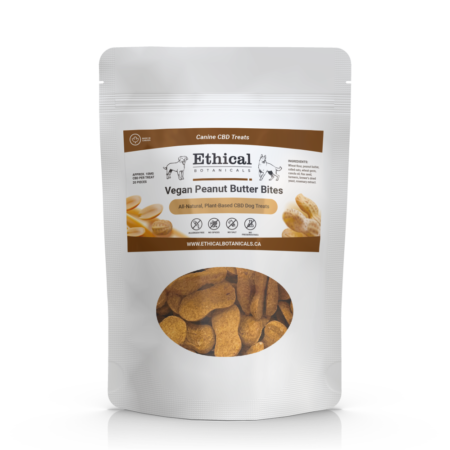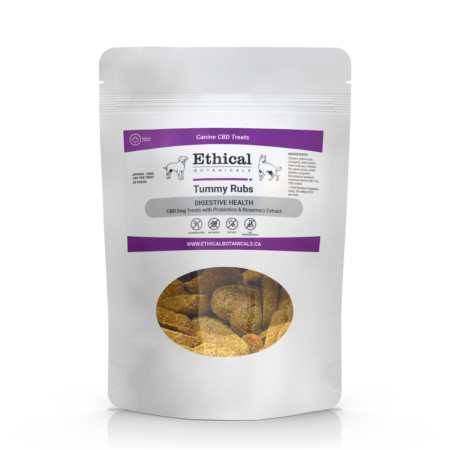The question “What can I give my dog for pain” occurs to every dog parent at some point. Everybody hates to see their dog in pain. Fortunately, there is a lot you can do to relieve your dog’s discomfort. In this article, we’ll give you information on how to better understand pain in dogs and how CBD oil can help you to manage your dog’s pain.
What underlying conditions cause long-term pain in dogs?
Pain relating to an injury is easy to diagnose. However, long-term chronic pain could be due to a broad variety of disease and ailments, many of which get more common as dogs age, just like us, humans. If your dog appears to be suffering from chronic pain, it’s possible that the following conditions are the cause:
- Arthritis
When the smooth cartilage that covers a dog’s joints starts to break down, the bones become exposed. The result is a painful wearing down of the bones. This condition mainly affects older dogs and is very painful.
- Bone cancer
Dogs suffer from many types of cancers, but bone cancer, “osteosarcoma,” is particularly painful. It mostly affects the front and back legs but can also affect other parts of the body. This is a very painful condition that often leads to death.
- Intervertebral disc disease
Intervertebral disc disease (IVDD) is a degenerative condition that affects older dogs. Doctors think the condition happens when discs lose their ability to hold water and become dehydrated. Dogs with disproportionally short and curved legs, like the Dachshund, tend to struggle with this painful condition that can cause permanent spinal cord damage and lead to paralysis.
- Pancreatitis
This is a painful condition that occurs when the pancreas becomes inflamed. The dog will experience severe abdominal pain similar to what humans experience when they have food poisoning.
- Periodontal disease
Poor dental hygiene can cause gingivitis, which eventually leads to the dog’s teeth loosening, loss of teeth, and jawbone decay all of which can be very painful.
 What are the signs that your dog is in pain?
What are the signs that your dog is in pain?
Dogs in pain give us all the signs we need to understand their predicament. They can’t speak, but if you know what to look for, it’ll be hard to miss what your dog is trying to tell you.
Physical symptoms of pain include shaking, trembling, an arched back, panting, and a change of posture with the head staying drooped below the shoulders.
You may notice some behavioral changes like constant licking, flinching when touched, abnormally frequent vocalization, inability to settle down, and even aggression.
When a dog starts to have mobility issues, it’s a clear sign that they are in pain. If they show an unwillingness to walk or would rather walk slowly, limp, refuse to go up or down stairs, or have consistent difficulty getting up to stand on all fours from the lying down position, it is time to go to the vet.
What can I give my dog for pain?
Vets often prescribe nonsteroidal anti-inflammatory drugs, or NSAIDs, developed especially for dogs, for cases of arthritis or for post-surgical pain. NSAIDs are used to treat both humans and pets and are generally safe, but overuse can cause damage to the kidneys, liver, or the digestive system.
Some prescription medication include opioids. Opioids can be highly effective, but the side effects can be serious and there is a potentially dangerous addiction risk.
But there are many other treatments beyond prescription medication that have been developed for both acute and chronic pain in dogs. These treatments include chiropractic, acupuncture, laser therapy, regenerative medicine, physical rehabilitation, homeopathy, osteopathy, massage, aromatherapy, flower essence, and herbal therapies.
The latest trend in pain management for humans and dogs is CBD oil. CBD isn’t quite mainstream yet, but by now, millions of people have tried it and the web is awash with positive testimonials. Since many of those people are dog owners, they’ve also tried CBD on their ailing pets, with a large number experiencing positive results.
What is CBD oil?
CBD oil is made from cannabidiol (CBD) and a carrier oil like MCT oil. CBD is extracted from a strain of cannabis known as hemp. Unlike marijuana—which produces mostly THC, hemp does not produce significant amounts of THC. Hemp produces large amounts of CBD but only 0.3% THC.
THC is the cannabinoid that gets you “high” whereas CBD is a cannabinoid that does not produce psychoactive effects. Dogs are much smaller than people and are very sensitive to THC. They shouldn’t get anything but a tiny amount of THC, or none at all.
CBD and THC are both cannabinoids. Amazingly, cannabis and hemp plants produce over 100 cannabinoids and we know little to nothing about most of them.
How does CBD work?
People have used cannabis for its medicinal qualities for many centuries, but scientists have only recently started research into the compound. A breakthrough happened in the early 1990s when scientists discovered the Endocannabinoid System (ECS). 
Humans, and all vertebrates—in fact, possess an endocannabinoid system (ECS). This system is a homeostatic regulator whose purpose is to regulate all other physical systems and promote homeostasis—a state of internal balance in which all of the body’s systems function optimally.
Our bodies produce compounds called endocannabinoids—a conjunction of endogeneous and cannabinoid. These are cannabinoids produced by our own bodies which acts as messengers in the ECS. CBD is a phytocannabinoid—which means a cannabinoid produced by a plant.
Just like our own endocannabinoids interact with receptors in our endocannabinoid system, so too does CBD. CBD’s interactions with the ECS are the main reasons why it can help with pain.
Though the science of medicinal cannabinoids is still young and the FDA only allows CBD to be prescribed in a few select cases, there’s an increasing number of doctors and veterinarians recommending CBD to patients and pets.
Currently there are many studies that demonstrate various CBD benefits in humans, but the number of studies conducted testing CBD’s effectiveness for dogs is still very small. Most evidence that CBD can be a helpful tool for managing various conditions comes in the form of anecdotal evidence from people recounting their own experiences with CBD on the web.
Is there any science backing using CBD for dogs?
Scientists have been studying the workings of CBD in humans and have found that it’s very effective for the relief of chronic pain in humans. CBD is also being used in palliative care to help patients manage their pain. A review of studies about the physiology of the endocannabinoid system and cannabinoids found that cannabinoids may lead to a new approach to pain management.
A review of multiple studies has shown that CBD is effective at controlling inflammation. CBD oil even has an anti-inflammatory effect and relieves pain when it is applied to the affected body part.
Hidden benefit: reduce pain medications
Scientists think that CBD helps opioids and NSAIDS to be more effective. This means that vets can prescribe a smaller dose of strong medications in addition to CBD oil, reducing the long-term negative effects of these narcotic drugs.
Side effects of CBD oil for dogs
Unwanted side effects because of CBD use are rare and include drowsiness, vomiting, diarrhea, itching, and dizziness. These effects are usually mild and disappear in due time. They are usually the result of using extremely high doses of CBD, and can be avoided with a “normal” small, moderate or high dose.
CBD may interact with other medications, in the same way that grapefruits interfere with the uptake of certain prescriptions drugs. If your dog is on medication, consult your vet before trying CBD.
Should I try CBD oil for my dog’s pain?
If your dog is suffering, there’s little reason not to try CBD oil. There’s no risk of harm, and a strong possibility of some improvement. The key is to source a CBD product that is safe and reliable coming from a reputable company that has had it’s product tested by a 3rd party laboratory to ensure it is safe and contains the amount of CBD claimed on the label.



